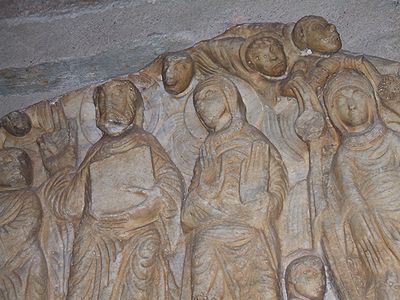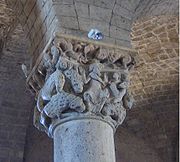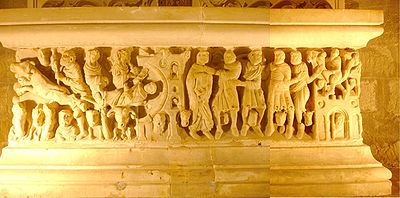
Master of Cabestany
Encyclopedia

Sculpture
Sculpture is three-dimensional artwork created by shaping or combining hard materials—typically stone such as marble—or metal, glass, or wood. Softer materials can also be used, such as clay, textiles, plastics, polymers and softer metals...
active in the second half of the 12th century. He was identified in the 1930s after the discovery of several pieces remarkable for their workmanship and their style; chief among these was the tympanum
Tympanum (architecture)
In architecture, a tympanum is the semi-circular or triangular decorative wall surface over an entrance, bounded by a lintel and arch. It often contains sculpture or other imagery or ornaments. Most architectural styles include this element....
of the church in Cabestany
Cabestany
Cabestany is a commune in the Pyrénées-Orientales department in southern France.The Master of Cabestany was from this area, and there is a museum dedicated to his work in the town.-References:*...
, from which he received his name. Subsequent research confirmed the presence of his works in the departments of Aude
Aude
Aude is a department in south-central France named after the river Aude. The local council also calls the department "Cathar Country".Aude is also a frequent feminine French given name in Francophone countries, deriving initially from Aude or Oda, a wife of Bertrand, Duke of Aquitaine, and mother...
and the Pyrénées-Orientales
Pyrénées-Orientales
Pyrénées-Orientales is a department of southern France adjacent to the northern Spanish frontier and the Mediterranean Sea. It also surrounds the tiny Spanish enclave of Llívia, and thus has two distinct borders with Spain.- History :...
, as well as in northern Catalonia
Catalonia
Catalonia is an autonomous community in northeastern Spain, with the official status of a "nationality" of Spain. Catalonia comprises four provinces: Barcelona, Girona, Lleida, and Tarragona. Its capital and largest city is Barcelona. Catalonia covers an area of 32,114 km² and has an...
; examples of his art have also been seen in Tuscany
Tuscany
Tuscany is a region in Italy. It has an area of about 23,000 square kilometres and a population of about 3.75 million inhabitants. The regional capital is Florence ....
and in Navarre
Navarre
Navarre , officially the Chartered Community of Navarre is an autonomous community in northern Spain, bordering the Basque Country, La Rioja, and Aragon in Spain and Aquitaine in France...
.
Discovery
The sculptor's work was first encountered in the 1930s with the discovery of a Romanesque-style tympanum, found during restoration work at the parish church of Cabestany. The high technical quality of the carving, combined with the originality of the theme drew the interest of scholars of medievalMiddle Ages
The Middle Ages is a periodization of European history from the 5th century to the 15th century. The Middle Ages follows the fall of the Western Roman Empire in 476 and precedes the Early Modern Era. It is the middle period of a three-period division of Western history: Classic, Medieval and Modern...
art, who began to compare the sculpture with other known works. They concluded that the carver was an as-yet unknown figure, dubbed the "Master of Cabestany", who was responsible for sculpting capital
Capital (architecture)
In architecture the capital forms the topmost member of a column . It mediates between the column and the load thrusting down upon it, broadening the area of the column's supporting surface...
s, sarcophogi, and corbel
Corbel
In architecture a corbel is a piece of stone jutting out of a wall to carry any superincumbent weight. A piece of timber projecting in the same way was called a "tassel" or a "bragger". The technique of corbelling, where rows of corbels deeply keyed inside a wall support a projecting wall or...
s that may still be seen in various religious structures.
In total, 121 sculptures have been attributed to the Master and to his studio
Studio
A studio is an artist's or worker's workroom, or the catchall term for an artist and his or her employees who work within that studio. This can be for the purpose of architecture, painting, pottery , sculpture, scrapbooking, photography, graphic design, filmmaking, animation, radio or television...
. He has also been the subject of numerous studies, in subjects ranging from theology
Theology
Theology is the systematic and rational study of religion and its influences and of the nature of religious truths, or the learned profession acquired by completing specialized training in religious studies, usually at a university or school of divinity or seminary.-Definition:Augustine of Hippo...
to history
History
History is the discovery, collection, organization, and presentation of information about past events. History can also mean the period of time after writing was invented. Scholars who write about history are called historians...
and art history
Art history
Art history has historically been understood as the academic study of objects of art in their historical development and stylistic contexts, i.e. genre, design, format, and style...
.

Style
The Master's sculptures share a peculiar style unlike that of most Romanesque sculptors. All of his human figures have low, triangular faces; crushed chins; high, deeply carved ears; almondAlmond
The almond , is a species of tree native to the Middle East and South Asia. Almond is also the name of the edible and widely cultivated seed of this tree...
-shaped eyes with trepanning holes at either end; hands with long, tapering fingers; many folds in the drapery; and a great deal of detailed work identifying the principal figures.
Recent developments
At the start of the 1990s, the town of Cabestany decided to make as much of the sculptor's work as possible available. Also, in 1993, after consultation with the inspector general of historic monuments, the town created a scientific committee composed of eminent French and European figures to select which of the Master's sculptures they found the most important and most representative. With their advice the town initiated the creation of mouldings taken from various works. , over 60 castings had been realized by sculptor Alphonse Snoeck using a method agreed upon by the national director of historic monuments. The castings are made with cast stoneCast stone
Cast stone is defined as “a refined architectural concrete building unit manufactured to simulate natural cut stone, used in unit masonry applications”. In the UK and Europe cast stone is defined as “any material manufactured with aggregate and cementitious binder, intended to resemble in...
which reproduces the same grain and color as may be seen in the originals, making them look identical to the original sculptures.
In 1994 the town acquired an old winemaking
Winemaking
Winemaking, or vinification, is the production of wine, starting with selection of the grapes or other produce and ending with bottling the finished wine. Although most wine is made from grapes, it may also be made from other fruit or non-toxic plant material...
cave with over 1,100 metres of surface area; this has served as the home for a center devoted to Romanesque sculpture since June 2004. The center serves three purposes, acting as a museum
Museum
A museum is an institution that cares for a collection of artifacts and other objects of scientific, artistic, cultural, or historical importance and makes them available for public viewing through exhibits that may be permanent or temporary. Most large museums are located in major cities...
, education center, and a center for research
Research
Research can be defined as the scientific search for knowledge, or as any systematic investigation, to establish novel facts, solve new or existing problems, prove new ideas, or develop new theories, usually using a scientific method...
and study. The museum area shows the permanent collection of castings, complementing them with rooms describing local history, art history, and the history of Romanesque sculpture; the last room showcases examples of other carvers contemporaneous with the Master. The sculpture castings are displayed in various ways, either fixed to the wall or freestanding, and are grouped in thematic displays as well. The museum also explains the historic and artistic contexts of the Master and his work.
Work

Pyrénées-Orientales
- CabestanyCabestanyCabestany is a commune in the Pyrénées-Orientales department in southern France.The Master of Cabestany was from this area, and there is a museum dedicated to his work in the town.-References:*...
- the tympanum of the parish church of Notre-Dame-des-Anges - Monastir del Camp - the capitals of the outer door are attributed to his studio
- Le BoulouLe BoulouLe Boulou is a commune in the Pyrénées-Orientales department in southern France.-References:*...
- the friezeFriezethumb|267px|Frieze of the [[Tower of the Winds]], AthensIn architecture the frieze is the wide central section part of an entablature and may be plain in the Ionic or Doric order, or decorated with bas-reliefs. Even when neither columns nor pilasters are expressed, on an astylar wall it lies upon...
on the outer door of the parish church of Sainte-Marie
Catalonia
- Sant Pere de RodesSant Pere de RodesSant Pere de Rodes is a former Benedictine monastery in the comarca of Alt Empordà, in the North East of Catalonia, Spain.-Location:It is in the municipal area of El Port de la Selva in the province of Girona, Spain. It has been constructed in the side of the Verdera mountain below the ruins of...
- some fragments of the now-destroyed door of the abbey church - Gérone - some capitals in the abbey church of Sant Pere de Galligants
Navarre
- Errondo - the tympanum from the church, which may today be found in The CloistersThe CloistersThe Cloisters is a museum located in Fort Tryon Park, New York City. The building, which is a branch of the Metropolitan Museum of Art, was reconstructed in the 1930s from the architectural elements of several European medieval abbeys...
of the Metropolitan Museum of ArtMetropolitan Museum of ArtThe Metropolitan Museum of Art is a renowned art museum in New York City. Its permanent collection contains more than two million works, divided into nineteen curatorial departments. The main building, located on the eastern edge of Central Park along Manhattan's Museum Mile, is one of the...
Aude
- Rieux-MinervoisRieux-MinervoisRieux-Minervois is a commune in the Aude department in southern France.-Population:-References:*...
- the capitals of the church of Saint-Marie; he was also the architect and chief artist of this church - Abbey of Saint-Hilaire - the reliquaryReliquaryA reliquary is a container for relics. These may be the physical remains of saints, such as bones, pieces of clothing, or some object associated with saints or other religious figures...
of Saint SaturninSaturninSaint Saturnin of Toulouse , with a feast day entered for November 29, was one of the "Apostles to the Gauls" sent out during the consulate of Decius and Gratus to Christianize Gaul after the persecutions under Emperor Decius had all but dissolved the small Christian communities...
in the abbey church - Abbey of Saint-Papoul - the sculptures in the apseApseIn architecture, the apse is a semicircular recess covered with a hemispherical vault or semi-dome...
of the abbey church - Abbey of Sainte-Marie de Lagrasse - some fragments of the now-destroyed door of the abbey church; some believe these to be products of his studio
Tuscany
- St. Antimo's AbbeySt. Antimo's AbbeySt. Antimo Abbey is a former Benedictine monastery, now inhabited by Canons Regular, situated in the province of Siena, near Montalcino, Tuscany, central Italy. A tributary of the river Orcia, the Starcia, runs near the abbey....
- a capital in the naveNaveIn Romanesque and Gothic Christian abbey, cathedral basilica and church architecture, the nave is the central approach to the high altar, the main body of the church. "Nave" was probably suggested by the keel shape of its vaulting...
of the abbey church depicting DanielDanielDaniel is the protagonist in the Book of Daniel of the Hebrew Bible. In the narrative, when Daniel was a young man, he was taken into Babylonian captivity where he was educated in Chaldean thought. However, he never converted to Neo-Babylonian ways...
in the lions' den - San Giovanni in Sugana - a sculpted columnColumnA column or pillar in architecture and structural engineering is a vertical structural element that transmits, through compression, the weight of the structure above to other structural elements below. For the purpose of wind or earthquake engineering, columns may be designed to resist lateral forces...
held today at the museum of religious art of San Casciano Val di Pesa
External links
This article is based on a translation of the corresponding article in the French Wikipedia.

